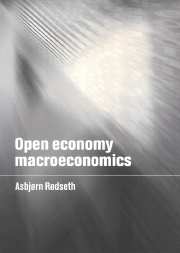Book contents
- Frontmatter
- Contents
- List of figures
- List of tables
- Preface
- List of standard symbols
- Introduction
- Part 1 Financial markets
- Part 2 The open economy
- 5 The extremely open economy
- 6 Home and foreign goods
- 7 Traded and non-traded goods
- 8 Alternative market structures, purchasing power parity and monopolistic competition
- Part 3 Policy issues
- Appendixes
- Notes
- Bibliography
- Index
6 - Home and foreign goods
Published online by Cambridge University Press: 06 July 2010
- Frontmatter
- Contents
- List of figures
- List of tables
- Preface
- List of standard symbols
- Introduction
- Part 1 Financial markets
- Part 2 The open economy
- 5 The extremely open economy
- 6 Home and foreign goods
- 7 Traded and non-traded goods
- 8 Alternative market structures, purchasing power parity and monopolistic competition
- Part 3 Policy issues
- Appendixes
- Notes
- Bibliography
- Index
Summary
In this chapter we assume that the home country and the foreign country produce goods which are imperfect substitutes. We label them ‘home’ and ‘foreign’ goods, respectively. We still look at a small country, but its products are different from those of the rest of the world, and their price can be influenced by conditions in the small country. This gives domestic demand a role in determining output and relative prices, and that is the main difference from chapter 5. However, the law of one price still holds, and we still have absolute purchasing power parity (PPP) in the sense that the same basket of commodities costs the same at home and abroad.
In section 6.1 we formulate an equation for the trade balance under these circumstances, and discuss the partial effects of a change in the exchange rate on the trade balance. In section 6.2 we formulate a model which integrates portfolio equilibrium with equations determining the trade balance and the level of activity. It is a short-run model with nominal price rigidity. Output is determined by demand. In sections 6.3 and 6.4 the model is used to discuss fiscal and monetary policy under fixed and floating exchange rates. Section 6.5 takes a critical look at some of the assumptions behind the model. In section 6.6 it is extended with dynamic equations relating inflation to the level of activity and the growth of the foreign debt to the current account deficit.
- Type
- Chapter
- Information
- Open Economy Macroeconomics , pp. 166 - 216Publisher: Cambridge University PressPrint publication year: 2000



